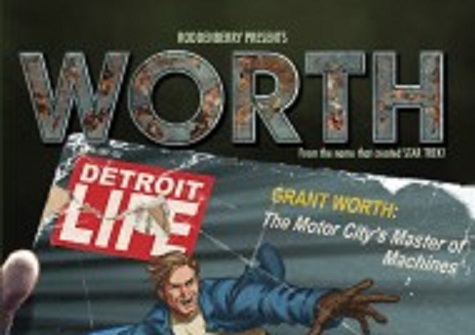
WORTH is penned by Aubrey Sitterson with Chris Moreno lending his hand to the art. The graphic novel from Roddenberry Entertainment will be available in hardcover April 2. Photo/Roddenberry Entertainment
[dropcap]S[/dropcap]uperheroes are known for amazing feats of strength and heroic deeds, often facing perilous danger for the greater good. But what happens when a good guy’s power is rendered obsolete, leaving the hero not so super?
That is the theme of Roddenberry Entertainment’s new graphic novel, WORTH. In the words of the novel’s author, Aubrey Sitterson, “It’s about a guy who is learning what it means when a superhero can no longer be super.”
On a larger scale, WORTH is about a former superhero named Grant Worth who was big in the Metro Detroit area in the 1960’s. Worth’s super power is mechanopathy, meaning he has the power to control and talk to machines, ranging from cars to guns to robots. Despite the hero’s success in the 1960’s, the present day Grant Worth is in a much different spot.
“It’s very much a story about the world leaving you behind,” Sitterson said. “(It’s) an ever changing landscape where you have to constantly reinvent yourself and find where you fit in. That’s the core but it’s also about man’s connection with machinery and technology and how humanity has to constantly reinvent themselves and figure out where we fit in.”
Both in the real world and in the novel, over time machines and humans have both come to rely more and more on technology, specifically computers. Without giving away any spoilers, this is the cause of Worth’s descent.
Computer chips interfere with his powers. Everything from ATM machines to today’s cars have computer chips in them, and when Worth attempts to use his powers, it causes him great distress. This is because computer chips are essentially “talking” all at once, which causes Worth to lose control of his powers and unable to concentrate to use them.
A powerful example of this is when he himself attempts to use an ATM machine. He is having problem withdrawing funds, so he attempts to use his powers to just talk to the ATM, but is literally screamed at by the machine itself. Artist Chris Moreno lent his hand to the project, illustrating scenes like the aforementioned.
“It was a great moment and it is a perfect example of how much Chris brought to the product,” Sitterson said. “This was the whole idea of how we were illustrating Grant’s powers. We were kind of at a loss for how to depict that and we shared that with Chris. He went off and he came back with this great idea.”
When Worth’s powers are being used you not only see the inner workings of those machines but you also see the inner workings of the hero himself. But things go awry when he attempts to use them on computer-based technologies.
“When the power works and all is good, you see blue. You see that in a flashback,” Sitterson said. “But then we get to the present and he’s trying to talk to the ATM, which is way more complicated, and he’s not able to make that same connection, red. It’s a really simple visual trick but those are the ones that work the best.”
The graphic novel, as mentioned, takes place in Detroit; and this wasn’t an accident.
“Detroit is a modern city that has modern struggles and it’s one of the things I looked at when I started writing this novel,” Sitterson said. “Once I started talking to the guys at Roddenberry about the nature of the story and my ideas … the piece that really brought it together was setting it in Detroit. It’s the perfect metaphor for what we’re talking about Grant going through.”
He added: “In fact, I don’t know which one is the perfect metaphor for the other.”
Worth really gives a new look at superheroes in the modern era and tells a powerful story not just about Grant Worth or the city of Detroit, but about our ever changing society as well.
WORTH will be hitting stores in print on April 2, with the full digital version available April 16. The first chapter of the graphic novel is available for free with chapters two and three available for $1.99 online now. Visit WheresYourWorth.com for more information. To listen to the interview: Download this episode (right click and save)






